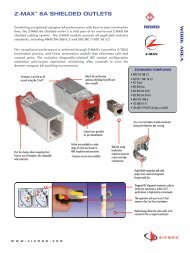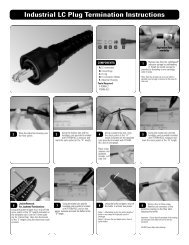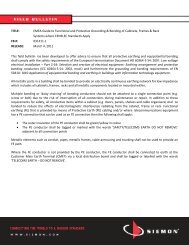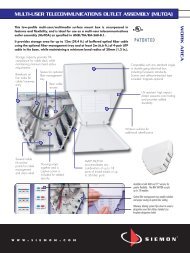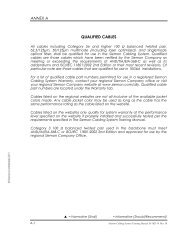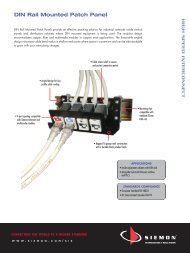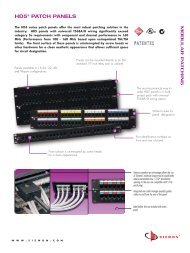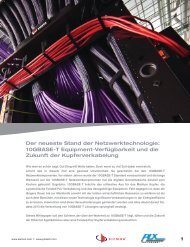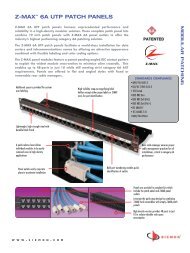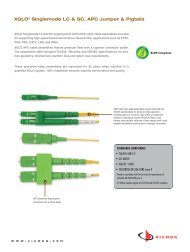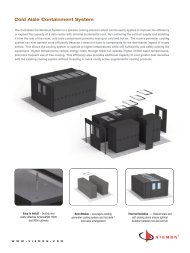SIEMON SYSTEM CATALOG
SIEMON SYSTEM CATALOG
SIEMON SYSTEM CATALOG
Create successful ePaper yourself
Turn your PDF publications into a flip-book with our unique Google optimized e-Paper software.
Entrance Facility, Telecommunications: An entrance to a building for both<br />
public and private network service cables (including antennae) beginning with<br />
the entrance point at the building wall and continuing to the entrance room or<br />
space.<br />
Entrance Point, Telecommunications: The point of emergence of telecommunications<br />
conductors through an exterior wall, a concrete floor slab, or<br />
from a rigid metal conduit or intermediate metal conduit.<br />
Equipment Cable: A cable or cable assembly used to connect telecommunications<br />
equipment to horizontal or backbone cabling.<br />
Equipment Room (ER): A centralized space for telecommunications equipment<br />
that serves the occupants of the building or multiple buildings in a campus<br />
environment. An equipment room is considered distinct from a<br />
telecommunications room because it is considered to be a building or campus<br />
serving (as opposed to floor serving) facility and because of the nature or<br />
complexity of the equipment that it contains.<br />
Equipment Room, Telecommunications: A centralized space for telecommunications<br />
equipment that serves the occupants of the building. An equipment<br />
room is considered distinct from the telecommunications room because<br />
of the nature and complexity of the equipment it houses.<br />
Far-end Crosstalk (FEXT): Crosstalk measured at the opposite end from<br />
which the disturbing signal is transmitted.<br />
Fiber Optic Transmission: A communications scheme whereby electrical<br />
data is converted to light energy and transmitted through optical fibers.<br />
Floor Distributor (FD): The international term for horizontal cross-connect.<br />
The distributor used to connect between the horizontal cable and other<br />
cabling subsystems or equipment.<br />
Fully Shielded twisted-pair (S/FTP): A balanced twisted-pair cable containing<br />
balanced twisted-pair conductors that are individually foil shielded,<br />
surrounded by an overall metallic braid, and bound in a single cable sheath.<br />
Ground: A conducting connection, whether intentional or accidental, between<br />
an electrical circuit (telecommunications) or equipment and earth, or to some<br />
conducting body that serves in place of the earth.<br />
Hertz (Hz): A measure of frequency as defined in units of cycles per second.<br />
Horizontal Cabling: The cabling between and including the telecommunications<br />
outlet and the horizontal cross-connect.<br />
Horizontal Cross-connect (HC): A cross-connect of horizontal cabling to<br />
other cabling, e.g., horizontal, backbone, or equipment.<br />
Hybrid Cable: An assembly of two or more cables, of the same or different<br />
types or categories, covered by one overall sheath.<br />
Insertion loss<br />
1. The loss resulting from the insertion of a device in a transmission<br />
line, expressed as the reciprocal of the ratio of the signal power<br />
delivered to that part of the line following the device to the signal<br />
power delivered to that same part before insertion.<br />
2. In an optical fiber system, the loss of optical power caused by inserting<br />
a component, such as a connector, coupler or splice, into a<br />
previously continuous optical path.<br />
Insulation Displacement Connection (IDC): A wire connection device that<br />
penetrates the insulation of a copper wire when it is being inserted (puncheddown)<br />
into a metal contact, allowing the electrical connection to be made.<br />
Interbuilding Backbone: Telecommunications cable(s) that are part of the<br />
campus subsystem that connect one building to another.<br />
Interconnection: A connection scheme that provides direct access to the<br />
cabling infrastructure and the ability to make cabling system changes using<br />
equipment cords.<br />
Intermediate Cross-Connect (IC): The connection point between a backbone<br />
cable that extends from the main cross-connect (first-level backbone)<br />
and the backbone cable from the horizontal cross-connect (second-level<br />
backbone).<br />
Intrabuilding Backbone: Telecommunications cable(s) that are part of the<br />
building subsystem that connect one equipment room to another.<br />
Jumper Wire: An assembly of twisted-pairs without connectors on either end<br />
used to join telecommunications links at a cross-connect.<br />
Laser Optimized: A multimode optical fiber with a refractive index profile<br />
optimized for use with laser light sources.<br />
Link: An end-to-end transmission path provided by the cabling infrastructure.<br />
Cabling links include all cables and connecting hardware that comprise<br />
the horizontal or backbone subsystems. Equipment and work area cables are<br />
not included as part of a link.<br />
Local Area Network (LAN): A geographically limited data communications<br />
system for a specific user group consisting of a group of interconnected computers,<br />
sharing applications, data and peripheral devices such as printers and<br />
CD-ROM drives intended for the local transport of data, video, and voice.<br />
Longitudinal Conversion Loss (LCL): A measure (in dB) of the differential<br />
voltage induced on a conductor pair as a result of subjecting that pair to longitudinal<br />
voltage. LCL is considered to be a measure of circuit balance.<br />
Main Cross-connect (MC): A cross-connect for first level backbone cables,<br />
entrance cables, and equipment cables.<br />
Modular Jack: A telecommunications outlet/connector for wire or cords as<br />
defined in the FCC Part 68 Subpart F. Modular jacks can have 4, 6 or 8 contact<br />
positions, but not all the positions need be equipped with contacts.<br />
Modular Plug: A telecommunications connector for wire or cords as defined<br />
in the FCC Part 68 Subpart F. Modular plugs can have 4, 6 or 8 contact positions,<br />
but not all the positions need be equipped with contacts.<br />
Multimedia:<br />
1. An application that communicates to more than one of the human<br />
sensory receptors.<br />
2. Applications that communicate information by more than one means<br />
or cabling media.<br />
Multimode Optical Fiber: An optical fiber that will allow multiple modes of<br />
light to propagate. The fiber may be either a graded-index or step-index fiber.<br />
Multimode optical fibers have a much larger core than singlemode fibers. See<br />
also Optical Fiber Cable.<br />
Multi-user Telecommunications Outlet Assembly (MuTOA): A grouping in<br />
one location of several telecommunications/outlet connectors.<br />
Nanosecond (ns): One billionth of a second (10 -9 seconds).<br />
Near-end Crosstalk (NEXT Loss): The undesired coupling of a signal from<br />
one pair of wires to another. Signal distortion as a result of signal coupling<br />
from one pair to another at various frequencies.<br />
Network Demarcation Point: The point of interconnection between the local<br />
exchange carrier’s telecommunication facilities and the telecommunications<br />
systems wiring and equipment the end user’s facility. This point shall be located<br />
on the subscriber side of the telephone company’s protector or the<br />
equivalent thereof in cases where a protector is not required.<br />
GLOSSARY<br />
www.siemon.com<br />
13.1



